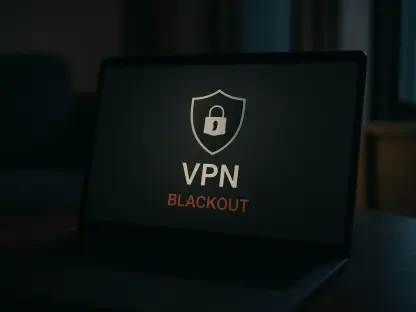As we dive into the ever-evolving world of network security, I’m thrilled to sit down with Matilda Bailey, a renowned networking specialist with deep expertise in cellular, wireless, and next-generation solutions. With her finger on the pulse of the latest technologies and trends, Matilda is the perfect person to help us unpack Cisco’s recent security updates for IOS and IOS XE. In this conversation, we’ll explore the critical vulnerabilities patched in this update, including a zero-day flaw already exploited in the wild, the varying severity of other bugs, and the urgent steps organizations need to take to safeguard their systems. Let’s get started.
Can you give us a broad picture of Cisco’s latest security update for IOS and IOS XE, including the scope of the vulnerabilities addressed?
Absolutely, Megan. Cisco recently rolled out patches for 14 vulnerabilities affecting their IOS and IOS XE operating systems, which are widely used in routers and switches. These flaws range in severity, with some posing critical risks. Among them, one zero-day vulnerability stands out because it’s already been exploited in real-world attacks. The update addresses issues across a variety of devices, including Meraki MS390 and Catalyst 9300 series switches, essentially impacting a broad spectrum of networking hardware running vulnerable software releases.
Let’s zoom in on that zero-day flaw, tracked as CVE-2025-20352. Can you explain what this vulnerability entails and how it impacts Cisco devices?
Sure. CVE-2025-20352 is a stack overflow issue in the Simple Network Management Protocol, or SNMP, subsystem of IOS and IOS XE. What this means is that by sending specially crafted SNMP packets to a vulnerable router or switch, an attacker can exploit this flaw. At a basic level, this can trigger a denial-of-service condition, effectively knocking the device offline. But the risk escalates significantly if the attacker has higher privileges, potentially allowing them to execute arbitrary code remotely as the root user, which is essentially full control over the device.
Speaking of privileges, what kind of access does an attacker need to exploit this zero-day flaw for something as serious as code execution?
For the more severe exploitation—like running code as the root user—an attacker needs specific credentials. According to Cisco, they must have either the SNMPv1 or v2c read-only community string, or valid SNMPv3 user credentials, paired with administrative or privilege level 15 access on the device. Without these, they’re limited to causing a denial-of-service attack, which is still disruptive but less catastrophic. The challenge is that if credentials are compromised, the door is wide open for much worse outcomes.
Given that this zero-day has already been exploited in the wild, what immediate actions should Cisco users take to protect their networks?
The first and most urgent step is to apply the patches Cisco has released. Since attackers are actively exploiting this flaw, often using compromised administrator credentials, delaying updates is not an option. Beyond patching, I’d recommend auditing access controls—ensure that SNMP credentials and administrative privileges are tightly secured and not easily guessable. Also, monitor network traffic for any unusual SNMP activity as an early warning sign. If possible, segment critical devices to limit exposure while updates are being rolled out.
Moving beyond the zero-day, Cisco also patched several other high-severity vulnerabilities in this update. Can you walk us through the potential dangers these pose?
Certainly. The update addresses eight high-severity flaws in addition to the zero-day. These bugs can lead to a range of serious issues, including denial-of-service conditions, arbitrary code execution during the boot process, command execution with root privileges, authentication bypass, and even data leaks. Essentially, these vulnerabilities could allow attackers to disrupt operations, gain unauthorized access, or steal sensitive information. The breadth of potential impact underscores why these patches are critical for any organization using affected Cisco devices.
There are also medium-severity bugs in this batch of patches. How concerned should organizations be about these, and what might happen if they’re exploited?
The five medium-severity vulnerabilities shouldn’t be ignored, even if they’re not as critical as the high-severity ones. These flaws could still cause significant headaches, like denial-of-service conditions, cross-site scripting attacks, command execution with root privileges, bypassing access control lists, or accessing the device’s public-key infrastructure server. While the impact might be less severe, they can still compromise system integrity or provide a foothold for attackers to escalate their attacks. Prioritizing them after the high-severity fixes is a smart approach, but they shouldn’t be left unaddressed for long.
Cisco mentioned that proof-of-concept exploit code exists for two of these medium-severity issues. Does that change the risk level, even if they haven’t been exploited yet?
It absolutely raises the stakes. When proof-of-concept code is out there, it lowers the barrier for attackers to weaponize these vulnerabilities. Even if Cisco hasn’t seen active exploitation of these specific flaws—tracked as CVE-2025-20240 and CVE-2025-20149—the existence of exploit code means that it’s only a matter of time before someone tries. It’s a red flag for organizations to patch these sooner rather than later, as the risk of exploitation increases significantly once the know-how is publicly available.
The update also covers vulnerabilities in other Cisco software, like SD-WAN vEdge and Wireless Access Point systems. What kinds of risks do these particular flaws introduce?
These patches address medium-severity bugs in Cisco’s SD-WAN vEdge, Access Point, and Wireless Access Point software. The risks here include things like bypassing access control lists, tampering with IPv6 gateways, and manipulating Device Analytics data. While Cisco hasn’t reported active exploitation of these issues, they could still disrupt network operations or allow attackers to alter configurations in ways that compromise security or performance. For organizations relying on these systems for critical operations, addressing these vulnerabilities is just as important as the others.
Looking ahead, what is your forecast for the evolving landscape of network security threats, especially concerning vulnerabilities in widely used systems like Cisco’s?
I think we’re going to see an ongoing cat-and-mouse game between vendors and attackers, especially with systems as ubiquitous as Cisco’s IOS and IOS XE. As more devices become interconnected, the attack surface grows, and zero-day flaws like CVE-2025-20352 will continue to be a major concern because they’re exploited before patches are even available. I expect attackers to increasingly target management protocols like SNMP, as they’re often less scrutinized than other vectors. On the flip side, vendors are getting faster at releasing patches, and I believe we’ll see more emphasis on proactive measures like secure-by-design principles and AI-driven threat detection to stay ahead of these risks. Organizations need to adopt a mindset of continuous vigilance—patching, monitoring, and hardening their systems will be more critical than ever.









